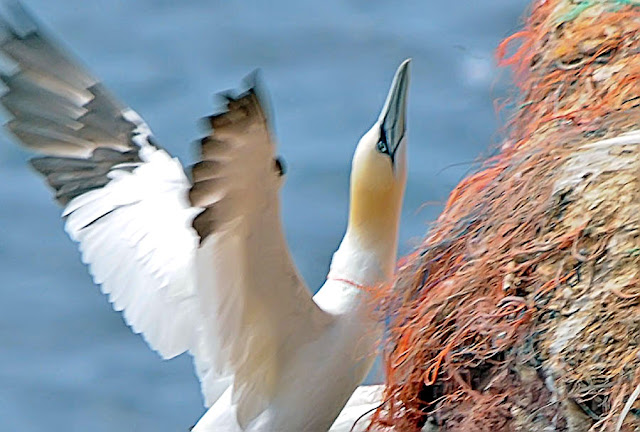(Warning: disturbing images)
The high point of my visit to my birth place in Germany in 2009 was a trip from Hamburg down the Elbe River to the diminutive island of Helgoland in the North Sea, 29 miles off the coast. The side facing the sea is a 200 feet high rock cliff, home to thousands of sea birds, mostly Northern Gannets, Common Murres and Black-legged Kittiwakes. It was a gorgeous day, bright sun, blue skies. I had only a few hours to photograph the birds, no way of avoiding the mid-day sun with its harsh lights and shadows. But losing myself in the moment, I was happy and kept firing away at the awe-inspiring assembly of nesting Northern Gannets.
Parental care: placing a feather
Macabre Discovery
The living and the dead: a recently dead adult bird in the left upper corner and the skeletal remains of one near center right among apparently oblivious adults and chicks
Is this adult going to be able to free itself from the sling around its neck?
These juveniles didn't make it
Fortunately this appears to be the only known Northern Gannet colony in the North Atlantic suffering such calamity. The North Sea is a shallow shelf sea ideal for shrimping with drag nets over its bottom. Nets are lost or torn apart and remain floating in the water or washed up on the beach. Gannets are known to resort to beachcombing for their nest material. Or perhaps they grab it when the nets are pulled in for mending.
Part of a trawl head on top of the rock. How on earth did it get up there?
Until then I had been content to archive my photos on my website; but now I had to write about it, hoping to bring this debacle to the public's attention. That's how I started my blog.
















.jpg)

WOW, how sad. I love the Gannet shots though. Awesome post and photos, Hilke!
ReplyDeletemy after such a wonderful tribute; love their sharing of the feather etc., a very sad demise to witness
ReplyDeletethey are beautiful birds. sad about the snagging in netting materials.
ReplyDeleteBeautiful images of these gorgeous birds Hilke, leading to what would seem to be a solvable problem. I would think that some international organizations like Birdlife International, the Council of Europe or The Nature Conservancy could work toward not only cleaning up that area, but protecting the breeding birds by not allowing trawling near the rock and removing the trawl head. I certainly hope something can be done there. It's tragic.
ReplyDeleteQuite disturbing images, unfortunatly I recently saw a Common Tern with fishing line around its body, fortunatly it didnt seem to be hindering its flying and feeding. Maybe just a lucky escape.... for now
ReplyDeleteLovely images Hilke. Such a shame about Gannets getting trapped in such a manner. You are right to bring this problem to a wider audience - good luck.
ReplyDeletethis is really sad to see. I was in Scotland and watched a lot of gannets but not this close. I don´t think the situation was like this at the places I visited. At least I did not see colors like this.
ReplyDeleteHi Hilke
ReplyDeleteThanks for sharing this story it needs to be told. It is sad we seem to ignore these problems rather than addressing them.
Regards
Guy
Wow excellent collection of pictures and nice that it was accompanied by a story which is true for a number of birds species! Unfortunately! I would love to get pictures of Gannet like yours, the free ones ;-)
ReplyDeleteA great series of images Hilke. Very troubling about the dead birds.
ReplyDeleteI remember visiting a couple of Gannett colonies, an overwhelming sensory experience.
Oh my gosh! Awful, but thank you for sharing -- helps us learn. I can't believe I have missed so many of your wonderful posts.
ReplyDeleteGood day! It was so great to visit this personal blog and to read this article. And there is also one thing which I wanted to ask you. Did you try guest blogging?
ReplyDeleteThank you for your visit and comment. I am a monthly guest blogger on Birding is Fun (http://www.birdingisfun.com/)
Delete